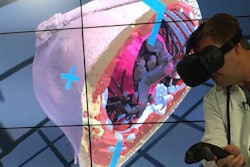"Image acquisition technologies and postprocessing techniques are continually advancing to give us faster acquisitions, lower doses, contrast reductions, spectral information, and beyond, but our 3D visualization techniques are still old-school," wrote Ahmed Halaweish, PhD, from the Mayo Clinic in Rochester, MN, in an email to AuntMinnie.com.
Beyond acquired 2D axial images, doctors still rely on reformats, sagittal and coronal, to create a 3D view of underlying anatomy. But the quality of 3D-rendered scenes is very basic and doesn't incorporate the viewing scene, the viewers' perspective, or proper light attenuation, Halaweish noted.
"Cinematic rendering is a photorealistic 3D rendering technique to facilitate a more in-depth 3D evaluation of the underlying anatomy, with improved depth of field and user- or scene-specific simulations for a more spatially and anatomically accurate rendering," he said.
The session will offer information on 3D rendering in clinical practice, as well as vascular, bone, and musculoskeletal techniques for 3D rendering of anatomical data. Also, you can learn about advanced visualization of anatomical structures through incorporation of global illumination maps and camera model simulations.
Stop by the educational event at Lakeside Learning Center for more information.



















